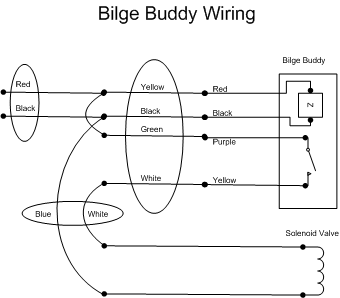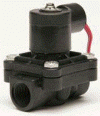
Fill Auto-Shutoff... What's a bilge?
We wanted a way to shut off incoming water when the tanks are full. This required two components, a sensor and a valve. The sensor is called a Bilge Buddy and it from Snake River Electronics, the same company that makes the other tank sensors. This installation uses the high water sensor of what is normally a two sensor system installed in the hull of a boat.
Bilge Buddy
When water reaches the sensor, a relay closes and the solenoid water valve on the input line closes to stop the incoming water. A secondary advantage is a "cycling" that fill all tanks evenly. The six cylinders are interconnected and will equalize their levels in a few seconds. So after the water is shut off initially, tanks equalize and a little more water is allowed in.
( Click to enlarge )
The Bilge buddy is mounted with the "thin" end down. When the water reaches the "step" near the middle, the relay closes very quickly. The lower photo shows the top of the tank, cut out for the sensor. The sensor was mounted with silicone caulk. The sensor is in the center, rear cylinder. This is one of the four small tanks. It is also the tank "closest" to the input fill line, so it should be the first to fill. After the input is shut off, all tanks should equalize in a few seconds and water inflow restart.
The sensor is installed using the same type of connector used for the taillight assemblies, Hoppy brand trailer connection units.
The color code for the connections is:
Bilge Buddy Wire Connector Wire Extend Wire Red Yellow Red Black Black Black Yellow Green Blue Purple White White Bilge Buddy manual in PDF format.
( Click to enlarge )
The diagram above shows the basic wiring diagram. Essentially, the Bilge Buddy is an normally open relay that closes when the water level triggers its sensor. The switched load, in our case is the coil of a solenoid operated water valve. In the typical marine application the load might be a bilge pump.
Ground is spliced at the connector for convenience. The diagram below shows the wiring harness used. The red/black pair runs to the fuse panel. The blue/white pair runs to the solenoid valve. As shown, all four conductors from the Bilge Buddy are connected to the connector pigtail, as listed in the table above. The green and yellow leads are then spliced to the incoming red, +12 v line.
Description of Operation From Manual
This device will activate the bilge pump when the top sensor detects water. It continues pumping until the bottom sensor returns a dry reading; at that time it begins a 5 second timer after which time it turns the pump off. You will observe 2 LEDs on the top controller portion of the device. The Top LED flashes at a regular interval. Each time this LED blinks the microcontroller has read both sensors. The bottom LED indicates the status of the pump; when the LED is lit the controller has detected water on the top sensor and has turned on the pump. When the system registers a dry bottom sensor the bottom LED will blink for about 5 seconds. This is the delay which further drains out the bilge below the bottom sensor. During this time the top LED does not blink as the sensors are not being updated. After a pump out cycle has completed the top LED will begin to blink again indicating that the sensors are updating again. When the system is first turned on it will begin a pump out cycle if water is detected on the bottom sensor. After this initial cycle the system will not pump out until water is detected on the top sensor.
Solenoid Valve
The solenoid operated valve, controlled by the Bilge Buddy, is mounted on the hose reel frame, between the hose reel output and the SHURflo filter unit.
Solenoid valve and filter assembly mounted on hose reel frame.
Valve is behind the aluminum plate. (Ignore the nut driver...)
Valve body, before installation Here is the PDF spec sheet for the valve. The spec sheet has the vendor's contact information. One important note... The valve must be normally OPEN. In other words, it will pass water until the Bilge Buddy activates and sends the control voltage to the valve to shut.
Apparently almost all solenoid valves are normally CLOSED, like the first one I ordered. When I first put water to the system, nothing happened. We want water to flow until the Bilge Buddy signals full, which is normally open. The vendor did caution, that the normally open valve should not be left activated for extended periods because it will overheat. After discussion, we decided an hour would be a safe, maximum, time for the valve to be activated. This shouldn't be a problem, it just means we can't hook up the water and go to bed and forget about it... I decided to put an alarm on the relay as a reminder. That should make the valve state easy to determine by sticking an ear out the door.





